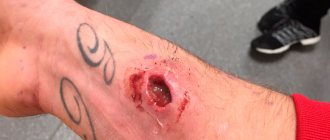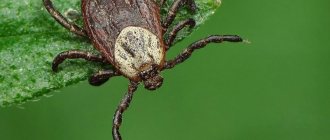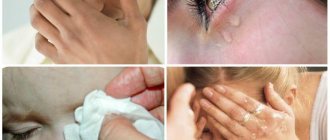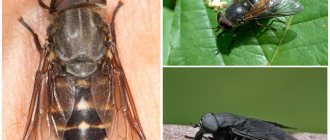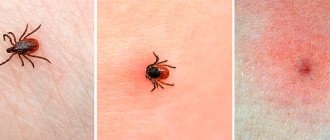Symptoms and first aid for spider bites
The first symptoms may appear within a few minutes, usually in the form of itching or redness. Therefore, first aid will be more effective if you have clear knowledge of what kind of spider bit you.
House spider
The site of a house spider bite on a person’s body looks very unpleasant, it swells, a focus of redness develops on the skin, and itching may be felt. Children and people with hypersensitivity may experience increased body temperature and dizziness. Therefore, the first thing you need to do (especially if it concerns a child) is to treat the wound with an antiseptic and consult a doctor to examine it.
Karakurt (male)
A spider bite is very dangerous and can be fatal. The main sign of such an attack is sharp pain from the bite; 10-15 minutes after the poison spreads, headache and shortness of breath appear, accompanied by pain in the chest, intestines and back. A person experiences psychomotor agitation, after which he may fall into an unconscious state and become delirious. The bite is especially dangerous for children, which can result in a coma or even death.
Experts recommend wearing protected shoes and clothing during agricultural work. Immediately after an insect bite, you need to consult a doctor; as a result of treatment, a serum will be introduced into the body that will help cope with the poison. The patient will immediately recover.
Black widow (female)
After a bite, the female spider, or black widow, injects a neurotoxic poison into the body. First aid must be provided immediately and immediately, for this you need to provide the person with plenty of fluids, treat the wound with an antiseptic, for example, hydrogen peroxide, and take antihistamines. Then call an ambulance and hospitalize the patient.
The first symptoms of a black widow bite are sharp pain and a small black dot that appears at the site of the bite, around which redness and painful swelling forms. After 5-6 hours, this area begins to fail and go numb, severe pain occurs when walking, and profuse sweating appears. Then the body turns blue, the skin turns dark. Breathing becomes difficult, shortness of breath, convulsions appear and, ultimately, paralysis of the limbs occurs.
Interesting. The venom of a black widow is 20 times stronger than the bite of a rattlesnake, from which even horses and camels die. Basically, spiders bite outside if a person is sitting on the grass, sleeping in the hayloft, or working in the garden.
Tarantula spider
The spider bite itself is painless, but after 6-7 minutes the affected area begins to swell, while the temperature begins to rise, and the bitten part of the body burns and breaks out. Chills occur, the body shakes, this is especially noticeable if the limbs have been bitten. The so-called body jitters appear.
After some time, the temperature rises, accompanied by dizziness and blurred vision. Then signs of nausea and vomiting appear. The veins begin to swell, and the skin darkens, becoming bluish in color, as with anemia. After this, after some time, the bones begin to ache; ordinary movements of the arm or leg are accompanied by pain syndromes.
The leg muscles become tense and may twist from trying to do something. Further paralysis of the limbs and body is possible. Signs of a bite, even after treatment, appear within a week.
Advice! As soon as you are bitten by a spider, seek medical treatment immediately as it can be fatal.
Tarantula
When bitten by this insect, two brown dots appear on the surface of the skin, from which lymph or colorless liquid flows. Then the skin temperature rises around these points, and the inflamed area swells.
The bite mark is quite noticeable, so the dots can be seen with the naked eye. Tarantula venom has a neurotoxic effect, i.e. it affects the nervous system, causing nervous muscle disorders and affecting the cardiovascular and respiratory systems. There is exhaustion of the nervous system, accompanied by convulsions and trembling.
In general, the consequences of exposure to poison are easily removable, but for people with allergies, the bite can be dangerous. As a result, soft tissue swelling occurs and, for example, if a person is bitten in the neck, suffocation can occur.
Cross
The bite of a cross spider is not dangerous, but can cause discomfort and tissue death. The insect bites, as a rule, only when it is picked up. There is a sharp painful sensation comparable to a bee sting, sometimes you don’t feel it at all. A white swelling forms on the affected area. After the poison has spread throughout the body, a person feels a headache, an increase in body temperature, joints begin to ache, subcutaneous hemorrhages and colic in the gastrointestinal tract are possible, green vessels are visible under the skin.
A white swelling at the site of the bite persists for seven days, then the swelling goes away. In this case, it is correct to immediately rinse the wound with water and treat it with an antiseptic solution, you can lubricate it with iodine, then, if you feel very unwell, consult a doctor who will prescribe drugs that neutralize the spider’s venom.
Recluse spider
Recluse spider bites are rarely fatal, however, the effects can be severe, including tissue damage and general body reaction. The bite is a thin red stripe that can stretch all the way to the chest of the human body. After 11-14 hours, symptoms appear in the form of malaise, fever, sweating and dizziness.
After 18 hours the body begins to swell. If timely treatment is not provided, the tumor becomes larger and larger, and if it does not go away later, the limb may be amputated. It is very important to consult a doctor promptly. Then a course of treatment is prescribed.<|span>
Karakurt
Karakurt (Latrodectus tredecimguttatus) is a poisonous spider that lives in Moldova, Crimea, and Central Asia. Females that have a pair of tubular poisonous glands located on the upper jaw are dangerous to humans. The poisonous segment (chelicerum) ends in a movable sharp claw with an opening for the duct of the poisonous gland. The female has a spherical, dense black abdomen with reddish spots. The length of the karakurt is about 10 mm.
Symptoms of poisoning with karakurt poison
After a bite, a small, quickly disappearing spot is formed. After 10-20 minutes, severe pain develops at the site of the lesion, which spreads to the abdomen, lower back, and chest. Severe mental agitation, headache, dizziness, suffocation, nausea, vomiting, weakness, shortness of breath, cyanosis, tachycardia, arrhythmia are observed. Severe drooling may begin. Possible respiratory arrest.
Black widow bite
The black widow spider (Latrodectus mactans) of the genus Latrodectus lives in the United States. The females of this species are very large: the paw span reaches 5 cm, and the body length is 1.5 cm. There is a red hourglass pattern on the black back.
Males are smaller, with a white mark on the back, the small size of the venomous apparatus and mild aggressiveness make them practically harmless to humans. When disturbed, they fall to the ground, fold their paws and pretend to be dead. Female black widows are venomous from the moment they are born. If they are guarding laid eggs or feel threatened, they prefer to attack. Spiders use their venom to paralyze prey, from which they then suck the hemolymph.
The period of post-copulatory passivity of the female allows the male to escape from his partner if she is not very hungry. If the female is hungry, then after mating she eats the “wife”, which is why she is called a “widow”.
Karakurt toxin is a protein with a molecular weight of 130,000. Under its action, ion channels are formed in the presynaptic membranes of nerve cells through which Ca 2++ ions enter the cell. Under the influence of the toxin, exocytosis of synaptic vesicles is facilitated and the release of gamma-aminobutyric acid (GABA), norepinephrine, and acetylcholine is enhanced.
Changes in intracellular homeostasis and an increase in the content of biologically active substances in the blood affect the functional state of the nervous and cardiovascular systems. In case of poisoning with karakurt poison, clinical manifestations develop within 30 minutes. The victim usually feels the sting and describes it as a "puncture". In the area of the spider bite, severe pain is noted, erythema and increased local sweating gradually increase.
Severity
When bitten by a black widow, there are three degrees of severity of the disease.
- I degree; moderate pain at the site of the bite, no general clinical manifestations of intoxication, all laboratory parameters are normal.
- II degree: muscle pain in the bitten limb. Pain spreading to the abdomen when a leg is bitten or to the chest when an arm is bitten. Profuse sweating at the site of the bite. Vital signs are normal.
- III degree: generalized muscle pain in the back, chest, abdomen. Strong mental agitation. Headache, dizziness, suffocation, nausea, vomiting, weakness, shortness of breath, cyanosis, arterial hypertension, tachycardia, arrhythmia. General profuse sweating. Severe drooling. Possible respiratory arrest. Blood tests show increased levels of creatine phosphokinase (CPK), leukocytosis, and proteinuria. In the absence of treatment, the maximum severity of symptoms lasts for 12 hours, the duration of intoxication is 48-72 hours.
in the photo on the left - the bite at the beginning, on the right - on the 3rd day.
Muscle spasms and tension in the muscles of the anterior abdominal wall sometimes become the reason for the erroneous diagnosis of peritonitis and the performance of unnecessary laparoscopy.
Preventive measures
To prevent bites from various types of spiders, you must:
- Wear shoes and clothing that completely cover the body when carrying out agricultural work.
- Do not pick up spiders, especially for small children.
- Do not lie on the grass and try not to sleep in haylofts in the open air, in places where these insects are most common.
- Carry out sanitary treatment of premises in a timely manner when identifying the location of poisonous spiders.
20 most effective spider repellents
There are a large number of insects around us that can cause serious harm to our health with their poison. Therefore, correct behavior in space plays an important role, especially in the vicinity of such dangerous pests. Be as vigilant as possible when walking with children to avoid unpleasant consequences. After all, the bite of a very poisonous spider can be stronger in its actions than a viper or cobra. Take care of yourself and your loved ones!
Treatment
Most spider bites are harmless and do not require special treatment. His capture - alive or in well-preserved condition - is necessary.
Treatment for spider bites includes washing the wound with soap and water and applying ice to reduce inflammation. Analgesics and antihistamines are used. Antibiotics are not recommended unless there is a bacterial infection. Treatment for black widow venom is aimed at controlling the resulting pain and nausea.
Learn more How to make a mousetrap with your own hands
If you are bitten by an Australian funnel-web spider or a Brazilian wandering spider, you should seek immediate medical attention. Antidote available.
Necrosis
In almost all cases, recluse bites are limited and usually heal without any medical intervention. Recommendations to limit the extent of injury include elevating and immobilizing the affected limb and applying ice.
Local wound care and tetanus prophylaxis are standard procedures. There is no established treatment for extensive necrosis.
Many treatments have been used including:
- hyperbaric oxygen;
- dapsone;
- antihistamines (cyproheptadine);
- antibiotics;
- dextran;
- glucocorticoids;
- vasodilators;
- heparin;
- nitroglycerine;
- electricity;
- scraping;
- surgical excision;
- antidote.
None of these methods give conclusive results. Studies have shown that surgery is ineffective and may worsen outcome. Excision delays wound healing, causes abscesses, and leads to unwanted scars.
Dapsone, an antibiotic, is used in the United States, Brazil to treat necrosis.
Antidote
The use of antivenom in severe cases is recommended, especially for neurotoxic venoms. Effective drugs exist for the poisons Latrodectus, Atrax, Phoneutria.
The drugs are available in intravenous form, but are rarely used. An anaphylactic reaction to the antidote results in death.
In Australia there is an antidote in intramuscular form, but there are doubts about its effectiveness. In South America the drug is available for Loxosceles lesions. This is the most promising therapy for recluse bites. Most effective when given early.
Bitten by a spider why diarrhea and not superpowers?
It seems to me that if any person were bitten by a SPIDER, then instead of superpowers, diarrhea would begin, or, to put it more delicately, diarrhea would begin.
Did the person have time to see the spider? What if it’s a tarantula, which is very poisonous in the spring, and what if it’s a scorpion – even worse.
Panic, diarrhea, diarrhea, sweat on the forehead from fear and horror - what kind of superpowers are there in such a situation?
There would be enough toilet paper until the ambulance arrived, and then, good!
Now the theme of “Spider-Man” is very popular, because schoolchildren or just children literally dream of becoming the same superhero. And since the film describes exactly this method of obtaining superpowers (a spider bite), everyone wants to be bitten. But in fact they only get problems:
The video describes the consequences of a spider bite. And diarrhea is far from the worst thing that can happen.
As for your question, the answer is simple - there are no superheroes, just like superpowers. There are only real things, like diarrhea, for example.
Usually, if a person is bitten by a spider , interesting things immediately happen to him. At least this is how all English scientists . Looking at the picture below, it’s hard to disagree with this, although if you look closely, it’s hard to believe that such sneakers exist (meaning the color).
Everything else inspires the wildest horror even when you think about it, but how can you go to the toilet now?
Will the bag behind you grow until it bursts, or should you think of something and do something about it before it’s too late? Tell me, in this situation (if everything happens quickly), does it really matter to a person what kind of stool he has at the moment?
Life is going to hell, and we are talking about diarrhea.. What will your spouse, children, work acquaintances and most importantly neighbors say? I wouldn’t think about him here at all, even if he walked continuously.
Living the rest of your life with crazy people (riding them on yourself for free) - this would actually be an interesting question, which can be solved with diarrhea in the future (they will pester you less, with rides and requests to go get beer).
And further. A false bite is quite possible.
When I saw it, I got scared, my knees sank and my pants were full of fear. But there was no bite as such. But fear and legs in liquid warmth instantly sent my head down the wrong path.
Here, if there are no swellings or stings under the skin, it is advisable to simply gather your thoughts and think about something good. For example, about the BV website.
Can you imagine how much money this question will bring in if one million people visit it every day?
I would quit my job right today, ask Abramovich where they make high-quality yachts and start going to a place where, in addition to bananas, the sea and white sand on the beach, there is only the sun, beautiful mulattoes and large shrimp.
Spiders. What are they?
Spiders (lat. Araneae, Aranei) are a detachment of arthropod animals of the arachnid class. Modern scientists know about 42,000 species of spiders. Almost all of them are predators, feeding mainly on various small insects (flies, mosquitoes, midges) and animals (frogs, lizards, small birds). About 2,900 species of spiders have been studied in the territory of the former USSR.
To capture their prey, spiders mainly weave webs, which in some species are silk. When the spider approaches its victim, it bites through it and, along with the bite, poison enters the victim’s body. That is why almost all spiders are poisonous; the only difference is the strength and nature of the poison, as well as the strength of the bite.
There are two types of spider venom - neurotoxic and hemolytic (necrotic). Most spiders have a neurotoxic venom, which, when it enters the victim’s body, causes serious disturbances in the functioning of its nervous system - the victim is paralyzed and dies. The hemolytic poison acts mainly on the human blood and skin, causing tissue death (necrosis).
Many small spiders are not able to bite through human skin, so they are not dangerous, but large spiders can easily deliver poison into the body.
Home spider
House spiders are found in almost any home - they are found in city apartments in block and brick high-rise buildings, and in private village houses. There are several varieties, the most common in everyday life are gray, brown and black.
The home refuge of black spiders is the far corners of closets, the space behind cabinets and sofas - furniture that is rarely moved, wooden window frames and logs from which the house is built. All places hidden from human eyes where no one can disturb the web they have woven.
House spider bites are quite rare, but if this happens, the bite sites on a person will hurt tolerably for one to two days. The bite of a house spider is a small swelling, but when compared to a mosquito bite, it is much larger and bright red in color.
A spider bites painfully - a person feels a sudden sharp prick, at first the bite sites look like small dots, then they swell, and a blurred red halo appears on the skin around the swelling.
Symptoms of such spider bites are dizziness, nausea, the temperature may rise, and itching and burning will appear at the puncture site, but such serious consequences of a spider bite are rare: as a rule, the bite of a black spider, most often of all species living in a person’s home, is not too toxic.
If you immediately apply an ice cube or simply make a cold compress, most likely, after a couple of days the bite marks will disappear.
But for people with weakened immune systems, those prone to allergies and young children, the consequences of such contact with spiders can be more serious: a person may experience weakness, may feel drowsy, digestion may be upset, and swelling at the site of the bite will last about 5 days .
If you have such symptoms after a spider bite, you should consult a doctor, especially if it concerns a child.
In general, there are no serious consequences from a bite, and they do not pose a threat to life, since the spider’s proboscis is long enough to bite just enough to pierce the skin, and it is not possible to inject poison under the skin.
Folk remedies for bites
What to do if a spider bite happens far from civilization, when you can’t get to the nearest populated area even in a couple of days?
To relieve unpleasant symptoms and speed up wound healing, you can use traditional medicine methods:
- Rinse the affected area with a solution - 1 teaspoon of vinegar per glass of water.
- Dilute baking soda with water to a paste and apply to the inflamed area.
- Wipe with lemon juice.
- Apply shaving foam for 5 minutes and rinse with cold water.
- Apply aloe leaves.
Attention! Any folk remedy, especially herbal ones, can provoke an allergic reaction and aggravate the condition of the victim. Therefore, it is better for allergy sufferers to refrain from such experiments.
After reading the presented review, many will wonder: is it possible to avoid a spider bite? To reduce the likelihood of an attack to a minimum, it is enough to follow some recommendations:
- Do not try to catch or hit the arthropod.
- Keep your home clean, not bypassing the most hidden corners.
- Once in nature, check your shoes and clothes, and keep your sleeping bags and tents closed.
- When going out of town, stock up on repellent sprays and creams.
- In the summer, close doors tightly and equip windows with mosquito nets.
In most cases, everything is limited to a local reaction, which goes away within a few days. Although no one is safe from meeting a dangerous individual. In order to promptly and competently respond to the consequences of a bite, it is important to equip your home first aid kit with everything you need, and when going into nature, take an “alarm suitcase” with you.
